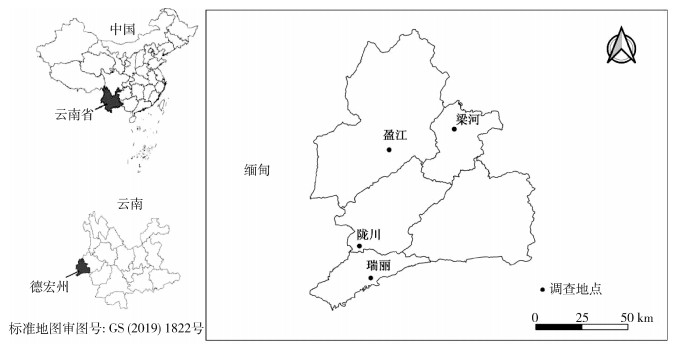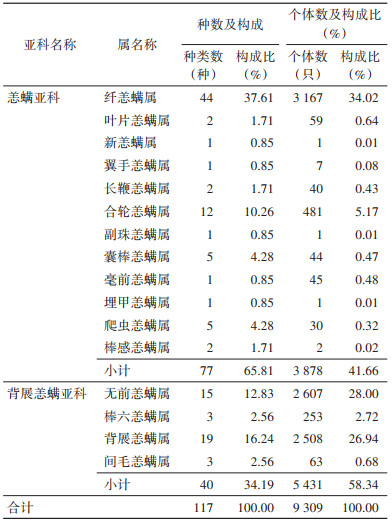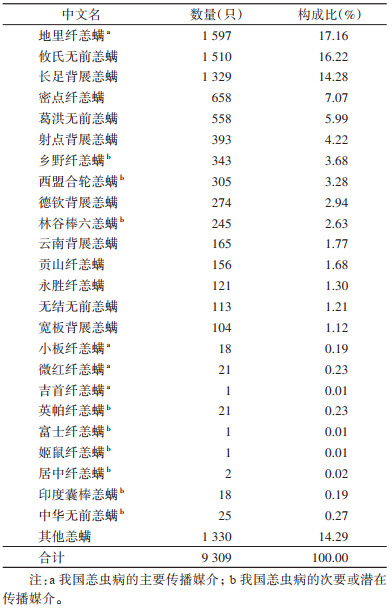扩展功能
文章信息
- 刘如金, 郭宪国, 赵成富, 张志伟, 赵亚飞, 范蓉, 宋文宇
- LIU Ru-jin, GUO Xian-guo, ZHAO Cheng-fu, ZHANG Zhi-wei, ZHAO Ya-fei, FAN Rong, SONG Wen-yu
- 云南省德宏傣族景颇族自治州小兽体表恙螨分类名录
- Catalogue of chigger mites on small mammals in Dehong Dai and Jingpo Autonomous Prefecture of Yunnan Province along the China-Myanmar border
- 中国媒介生物学及控制杂志, 2024, 35(3): 349-357
- Chin J Vector Biol & Control, 2024, 35(3): 349-357
- 10.11853/j.issn.1003.8280.2024.03.017
-
文章历史
- 收稿日期: 2023-11-08
恙螨(chigger mite或trombiculid mite)是恙虫病(scrub typhus或tsutsugamushi disease)的唯一传播媒介,还可以作为肾综合征出血热(hemorrhagic fever with renal syndrome,HFRS)的潜在传播媒介[1-2]。恙螨生活史包括了卵、次卵或前幼虫、幼虫、若蛹、若虫、成蛹和雌雄成虫7个时期,幼虫是唯一体表寄生时期,其余各期自由生活[3]。恙螨幼虫是重要的体表寄生虫类群,主要寄生在鼠类等小型哺乳动物(小兽)体表,靠刺吸鼠类等宿主动物的血液、淋巴液和组织液为生[4-5]。鼠类等小兽是恙虫病的主要动物传染源和储存宿主,恙螨幼虫是传播媒介,通过恙螨幼虫的叮咬,恙虫病东方体(Orientia tsutsugamushi,Ot)可以从鼠类等动物传给人或在不同动物宿主之间传播[6-7]。
中国大陆31个省(自治区、直辖市)均有恙虫病病例报告,近年发病人数不断增加,已成为一个严重的公共卫生问题[8]。地处中缅边境的云南省德宏傣族景颇族自治州(德宏州)是恙虫病流行的重灾区,恙虫病历年发病率位居云南省前列[9]。德宏州境内国境线长503.8 km,占整个中缅国境线22.8%,是中国与缅甸两国经贸往来最频繁的边境地区之一,人口密集,人员流动频繁[10]。与德宏州接壤的缅甸北部地区,恙虫病发病率很高,恙虫病流行十分严重,随时可以传入德宏州境内[11-12]。除了恙虫病高发外,德宏州境内还存在HFRS流行[13]。此外,德宏州地处喜马拉雅山脉南缘、怒江西岸,境内气候温暖、潮湿,动植物资源丰富[14-15],是恙螨孳生的理想场所。
恙螨是一类节肢动物的统称,种类繁多,全球已知恙螨3 000多种,对恙螨的种类鉴定主要依靠传统分类学技术,目前尚无其他替代手段[16],分类鉴定结果往往以分类名录来展现[17]。在现场调查和恙螨采集基础上,通过对2008-2022年现场调查采集的恙螨进行分类,本文首次报道了德宏州的恙螨分类名录。国内外对恙螨的分类鉴定一直是以幼虫形态为依据[18]。本文所指“恙螨”全部为恙螨幼虫。
1 材料与方法 1.1 现场调查点概况德宏州地处中国云南省西部、高黎贡山西南麓,属滇西峡谷区。德宏州共有5个县级行政区,境内大部分区域位于热带和南亚热带[19-20]。本研究的现场调查资料来源于2008-2022年本课题组对德宏州的现场调查。共计调查瑞丽、陇川、梁河和盈江4个县(市),其中陇川、瑞丽和盈江县(市)均与缅甸接壤,见图 1。

|
| 图 1 云南省德宏傣族景颇族自治州及本次调查点的地理位置 Figure 1 Geographical location of four survey sites and Dehong Dai and Jingpo Autonomous Prefecture in Yunnan Province, China |
| |
调查当天下午或傍晚,随机布放加有食饵的鼠笼诱捕小兽,次日清晨逐一检查小兽的捕获情况,将捕获到的宿主动物装入密封布袋中,带回现场临时实验室,按照常规方法麻醉后,逐一采集其体表的恙螨幼虫。按照“一兽一瓶”的原则,将所采集的恙螨幼虫置于盛有70%乙醇溶液的离心管内固定保存备用[21]。采集完毕,根据宿主动物的大小、毛色、外部形态和相关测量指标(体质量、体长、尾长、耳高、后足长等),对照分类鉴定文献,鉴定其种类。难以现场鉴定的疑难标本,剥制头骨标本,再结合牙齿和头骨特征进行进一步鉴定。所参考的分类鉴定资料见文献[22-26]。
1.3 恙螨玻片标本制作与分类鉴定在实验室内,将保存于70%乙醇溶液的恙螨幼虫转移至盛有蒸馏水的培养皿中,冲洗2~3次。在体视显微镜(解剖镜)下,用解剖针等工具去除宿主皮屑、分泌物、尘土等非螨杂质后,用霍氏封固液(Hoyer’s solution)封片,制成玻片标本。所制作的恙螨玻片标本,经脱水、干燥、透明后,置光学显微镜(奥林巴斯公司,日本东京)下进行观察、比对和显微测量。根据形态学综合特征及显微测量数据,对照分类检索表和相关分类文献,将每只恙螨逐一鉴定到种[21]。难以准确鉴定到种的标本,以“待定种”计入原始数据。所参考的分类鉴定资料见文献[27-32]以及在国内外期刊公开发表的恙螨分类文章等[17]。
2 结果 2.1 宿主动物分类鉴定结果2008-2022年从4个调查地区共捕获鼠类等小兽1 760只,经分类鉴定,隶属于啮齿目(Rodentia)、劳亚食虫目(Eulipotyphla,旧称食虫目Insectivora)和攀鼩目(Scandentia)3个目中的9科16属27种。啮齿目(鼠类)的种类数(19/27,70.37%)和个体数(1 486/1 760,84.43%)均占优势,其次是劳亚食虫目(表 1)。在所鉴定出的1 760只小兽宿主中,黄胸鼠(Rattus tanezumi)、大绒鼠(Eothenomys miletus)、臭鼩(Suncus murinus)和黑缘齿鼠(R. andamanensis)是优势小兽宿主,其中黄胸鼠数量构成比最高(917/1 760,52.10%),其次是大绒鼠(296/1 760,16.82%)、臭鼩(126/1 760,7.16%)和黑缘齿鼠(122/1 760,6.93%)。其他23种小兽宿主构成比为16.99%(299/1 760),构成比较高的是安氏白腹鼠(Niviventer andersoni)、白尾梢大麝鼩(Crocidura dracula)、白尾鼹(Parascaptor leucura)、板齿鼠(Bandicota indica)和北社鼠(N. confucianus)。

|
从德宏州4个调查地区所捕获的1 760只小兽宿主体表共采集到恙螨9 309只,被分类鉴定为1科[恙螨科(Trombiculidae)]2亚科[恙螨亚科(Trombiculinae)和背展恙螨亚科(Gahrliepiinae)]16属117种。在恙螨亚科、背展恙螨亚科的16个属中,纤恙螨属的种类数(44种)最高,其次是背展恙螨属(19种)和无前恙螨属(15种)。纤恙螨属的个体数(3 167只)最多,其次是无前恙螨属(2 607只)和背展恙螨属(2 508只)(表 2)。在117种恙螨中,地里纤恙螨(Leptotrombidium deliense)、攸氏无前恙螨(Walchia ewingi)和长足背展恙螨(Gahrliepia longipedalis)的数量较多,为优势螨种,其数量构成比分别为17.16%(1 597/9 309)、16.22%(1 510/9 309)和14.28%(1 329/9 309)。3种优势恙螨合计数量构成比为47.65%(4 436/9 309)。

|
按照恙螨的科、亚科、属和种的逐级分类层次,对从德宏州4个调查地区所鉴定出的1科2亚科16属117种恙螨的分类名录进行归纳整理(表 3、4)。其中,地里纤恙螨、攸氏无前恙螨、长足背展恙螨、密点纤恙螨(L. densipunctatum)、葛洪无前恙螨(W. kor)、射点背展恙螨(G. radiopunctata)、乡野纤恙螨(L. rusticum)、西盟合轮恙螨(H. simena)、德钦背展恙螨(G. deqinensis)、林谷棒六恙螨(S. ligula)、云南背展恙螨(G. yunnanensis)、贡山纤恙螨(L. gongshanense)、永胜纤恙螨(L. yongshengense)、无结无前恙螨(W. enode)和宽板背展恙螨(G. latiscutata)15种主要恙螨合计构成比为84.55%(7 871/9 309)。

|

|
本研究调查点位于云南省西南边境的德宏州,地处中缅边境线上,是恙虫病的主要流行区和疫源地之一[33]。在4个调查地区中,瑞丽市、盈江县和陇川县均与缅甸接壤[34],是重要的边境旅游区,人员流动频繁[35]。在与德宏州接壤的缅甸北部地区,恙虫病流行十分严重,随时都有可能传播到德宏州[11-12]。德宏州4个调查点鉴定出117种恙螨,超过了中国其他各省恙螨种类记载数,甚至超过几个省记载数之和,如湖北省记载恙螨41种[36]、福建省记载53种[37]、中国西北地区(陕西省、宁夏回族自治区、甘肃省、青海省和新疆维吾尔自治区)记载81种[38]。本研究表明,德宏州的恙螨种类十分丰富,物种多样性很高,这可能与德宏州的特殊地理位置、复杂气候类型和海拔垂直梯度变化较大有关[14-15]。
地里纤恙螨、攸氏无前恙螨和长足背展恙螨3种恙螨是德宏州境内的优势恙螨种类,其中以地里纤恙螨的数量构成比最高。黄胸鼠、大绒鼠、臭鼩和黑缘齿鼠是本次德宏州捕获的主要小兽宿主。地里纤恙螨不仅是中国和东南亚恙虫病最主要的传播媒介,也是世界上许多地区恙虫病的主要或重要传播媒介[39]。黄胸鼠、大绒鼠、臭鼩和黑缘齿鼠是恙虫病等多种人兽共患病的重要传播宿主[40]。黄胸鼠、大绒鼠、臭鼩和黑缘齿鼠及地里纤恙螨在德宏州的大量存在,增加了该地恙虫病持续存在流行和传播的风险,增大了恙虫病从动物传播给人的概率,应当引起高度重视。
恙螨幼虫是恙虫病的唯一传播媒介。我国已经确证的恙虫病6种主要媒介是地里纤恙螨、微红纤恙螨、吉首纤恙螨、高湖纤恙螨(L. gaohuense)、海岛纤恙螨(L. insulare)和小板纤恙螨。此外,我国还存在十几种恙虫病的次要或潜在媒介螨种,如古丈纤恙螨(L. guzhangensis)、英帕纤恙螨、苍白纤恙螨(L. pallidum)、须纤恙螨(L. palpale)等[41]。本文结果显示,除了中国恙虫病最主要的传播媒介地里纤恙螨外,德宏州境内还存在小板纤恙螨、微红纤恙螨、吉首纤恙螨、乡野纤恙螨、英帕纤恙螨、富士纤恙螨、姬鼠纤恙螨、居中纤恙螨、西盟合轮恙螨、印度囊棒恙螨、中华无前恙螨和林谷棒六恙螨,这些媒介恙螨的存在,进一步增加了该地恙虫病持续存在、流行和传播的风险。在本文所调查的4个县(市)中,瑞丽市、陇川县是我国边境各类传染病防控的重要区域[42]。提示在对包括恙虫病在内的各类传染病的监测、防控中,还应当增加对媒介恙螨的监测和防控。
志谢 本文原始资料来源于此前的大量现场调查和分类鉴定,邹云集、王乔花、张勇、高聪华、赵南、普昌吉、欧阳德才、部分研究生和本科生等参与了部分现场调查、标本制作和分类鉴定等工作,特此志谢利益冲突 无
| [1] |
Song WY, Lv Y, Yin PW, et al. Potential distribution of Leptotrombidium scutellare in Yunnan and Sichuan provinces, China, and its association with mite-borne disease transmission[J]. Parasit Vectors, 2023, 16(1): 164. DOI:10.1186/s13071-023-05789-y |
| [2] |
Chen YL, Guo XG, Song WY, et al. Infestation and distribution of chigger mites on Confucian white-bellied rat (Niviventer confucianus) in southwest China[J]. Biologia, 2022, 78(3): 727-736. DOI:10.1007/s11756-022-01261-x |
| [3] |
Bendjeddou ML, Khelfaoui F, Abiadh A, et al. Bat ectoparasites (Acari, Diptera, Hemiptera, Siphonaptera) in the Grand Maghreb (Algeria, Libya, Mauritania, Morocco and Tunisia): A literature review and new data[J]. Acta Parasitol, 2024, 69(1): 106-120. DOI:10.1007/s11686-023-00732-8 |
| [4] |
Li B, Guo XG, Zhao CF, et al. Infestation of chigger mites on Chinese mole shrew, Anourosorex squamipes, in southwest China and ecological analysis[J]. Parasite, 2022, 29: 39. DOI:10.1051/parasite/2022038 |
| [5] |
Guo Y, Guo XG, Peng PY, et al. Infestation and distribution of chiggers on the Anderson's white‐bellied rats in southwest China[J]. Vet Med Sci, 2023, 9(6): 2920-2926. DOI:10.1002/vms3.1275 |
| [6] |
Walker DH, Mendell NL. A scrub typhus vaccine presents a challenging unmet need[J]. npj Vaccines, 2023, 8(1): 11. DOI:10.1038/s41541-023-00605-1 |
| [7] |
Chen YL, Guo XG, Ding F, et al. Infestation of oriental house rat (Rattus tanezumi) with chigger mites varies along environmental gradients across five provincial regions of southwest China[J]. Int J Environ Res Public Health, 2023, 20(3): 2203. DOI:10.3390/ijerph20032203 |
| [8] |
岳玉娟, 王玉姣, 李贵昌, 等. 2006-2018年中国大陆恙虫病高发区流行病学特征分析[J]. 疾病监测, 2020, 35(4): 301-306. Yue YJ, Wang YJ, Li GC, et al. Epidemiological characteristics of scrub typhus in high-incidence areas in Chinese mainland, 2006-2018[J]. Dis Surveill, 2020, 35(4): 301-306. DOI:10.3784/j.issn.1003-9961.2020.04.007 |
| [9] |
Peng PY, Xu L, Wang GX, et al. Epidemiological characteristics and spatiotemporal patterns of scrub typhus in Yunnan Province from 2006 to 2017[J]. Sci Rep, 2022, 12(1): 2985. DOI:10.1038/s41598-022-07082-x |
| [10] |
周灿, 赵一默. 边境地区大旅游产业发展研究: 以德宏州为例[J]. 学术探索, 2016(6): 79-85. Zhou C, Zhao YM. Development of great tourism in the border areas: A case study of Dehong[J]. Acad Exp, 2016(6): 79-85. DOI:10.3969/j.issn.1006-723X.2016.06.013 |
| [11] |
Elders PND, Swe MMM, Phyo AP, et al. Serological evidence indicates widespread distribution of rickettsioses in Myanmar[J]. Int J Infect Dis, 2021, 103: 494-501. DOI:10.1016/j.ijid.2020.12.013 |
| [12] |
Win AM, Nguyen YTH, Kim Y, et al. Genotypic heterogeneity of Orientia tsutsugamushi in scrub typhus patients and thrombocytopenia syndrome co-infection, Myanmar[J]. Emerg Infect Dis, 2020, 26(8): 1878-1881. DOI:10.3201/eid2608.200135 |
| [13] |
靳寿华, 张海林, 杨卫红, 等. 云南省1976-2012年肾综合征出血热流行特征分析[J]. 中国媒介生物学及控制杂志, 2013, 24(6): 498-502. Jin SH, Zhang HL, Yang WH, et al. Epidemiological analysis of hemorrhagic fever with renal syndrome during 1976 to 2012 in Yunnan Province, China[J]. Chin J Vector Biol Control, 2013, 24(6): 498-502. DOI:10.11853/j.issn.1003.4692.2013.06.006 |
| [14] |
贺东北, 柯善新, 何勒定, 等. 德宏州森林资源特点与经营管理研究[J]. 中南林业调查规划, 2017, 36(2): 1-4, 25. He DB, Ke SX, He LD, et al. The study of forest resource characteristic, operation and administration of Dehong Prefecture[J]. Cent South For Inventory Plan, 2017, 36(2): 1-4, 25. DOI:10.16166/j.cnki.cn43-1095.2017.02.001 |
| [15] |
李宏刚, 张飞燕, 滕雪娇, 等. 德宏州野生动物繁育利用的现状调查分析[J]. 野生动物学报, 2019, 40(1): 87-93. Li HG, Zhang FY, Teng XJ, et al. The status of wildlife breeding and utilization in Dehong Prefecture[J]. Chin J Wildl, 2019, 40(1): 87-93. DOI:10.19711/j.cnki.issn2310-1490.2019.01.013 |
| [16] |
Nielsen DH, Robbins RG, Rueda LM. Annotated world checklist of the Trombiculidae and Leeuwenhoekiidae (1758–2021) (Acari: Trombiculoidea), with notes on nomenclature, taxonomy, and distribution[J]. Zootaxa, 2021, 4967(1): 1243. DOI:10.11646/zootaxa.4967.1.1 |
| [17] |
Ashani MLS, Gunathilaka PADHN, Premarathne BAHR, et al. Annotated checklist of chigger mites (Trombidiformes: Leeuwenhoekiidae, Trombiculidae and Walchiidae) in Sri Lanka[J]. Vet Parasitol Reg Stud Reports, 2022, 34: 100771. DOI:10.1016/j.vprsr.2022.100771 |
| [18] |
Li B, Guo XG, Ren TG, et al. Analysis on infestation and related ecology of chigger mites on large Chinese voles (Eothenomys miletus) in five provincial regions of southwest China[J]. Int J Parasitol Parasites Wildl, 2022, 19: 169-179. DOI:10.1016/j.ijppaw.2022.08.013 |
| [19] |
龚舒静, 杨金汉, 张之春. 德宏不同海拔下西南桦生长表现研究[J]. 绿色科技, 2022, 24(21): 173-176. Gong SJ, Yang JH, Zhang ZC. Analysis on growth performance of Betula alnoides at different altitude in Dehong Prefecture[J]. J Green Sci Technol, 2022, 24(21): 173-176. DOI:10.16663/j.cnki.lskj.2022.21.043 |
| [20] |
吴志湘, 赵家富, 陈茂云, 等 . 德宏州志 综合卷[M]. 德宏: 德宏民族出版社, 1994: 110-116. Wu ZX, Zhao JF, Chen MY, et al. Comprehensive records of Dehong Prefecture[M]. Dehong: Dehong Minzu Press, 1994: 110-116. |
| [21] |
Peng PY, Guo XG, Song WY, et al. Analysis of ectoparasites (chigger mites, gamasid mites, fleas and sucking lice) of the Yunnan red-backed vole (Eothenomys miletus) sampled throughout its range in southwest China[J]. Med Vet Entomol, 2015, 29(4): 403-415. DOI:10.1111/mve.12134 |
| [22] |
黄文几, 陈延熹, 温业新 . 中国啮齿类[M]. 上海: 复旦大学出版社, 1995: 1-286. Huang WJ, Chen YX, Wen YX. Rodents of China[M]. Shanghai: Fudan University Press, 1995: 1-286. |
| [23] |
魏辅文, 杨奇森, 吴毅, 等. 中国兽类名录(2021版)[J]. 兽类学报, 2021, 41(5): 487-501. Wei FW, Yang QS, Wu Y, et al. Catalogue of mammals in China (2021)[J]. Acta Theriol Sin, 2021, 41(5): 487-501. DOI:10.16829/j.slxb.150595 |
| [24] |
史密斯·安德鲁, 解焱. 中国兽类野外手册[M]. 陈延熹, 杨戎生, 张劲硕, 等译. 长沙: 湖南教育出版社, 2009: 31-184. Smith AT, Xie Y. A guide to the mammals of China[M]. Chen YX, Yang RS, Zhang JS, et al, trans. Changsha: Hunan Education Publishing House, 2009: 31-184. (in Chinese) |
| [25] |
Wilson DE, Lacher TE, Mittermeier RA. Handbook of the mammals of the world: Vol. 6. Lagomorphs and rodents Ⅰ[M]. Barcelona: Lynx Edicions, 2016: 1-407.
|
| [26] |
Wilson DE, Mittermeier RA, Lacher TE, et al. Handbook of the mammals of the world: Vol. 7. Rodents Ⅱ[M]. Barcelona: Lynx Edicions, 2017: 1-352.
|
| [27] |
黎家灿, 王敦清, 陈兴保. 中国恙螨: 恙虫病媒介和病原体研究[M]. 广州: 广东科技出版社, 1997: 97-551. Li JC, Wang DQ, Chen XB. Trombiculid mites of China: Studies on vector pathogen of tsutsugamushi disease[M]. Guangzhou: Guangdong Science & Technology Press, 1997: 97-551. |
| [28] |
叶向光. 常见医学蜱螨图谱[M]. 北京: 科学出版社, 2020: 263-343. Ye XG. Atlas of common medical ticks and mites[M]. Beijing: Science Press, 2020: 263-343. |
| [29] |
Vercammen-Grandjean PH, Langston RL. The chigger mites of the world, Vol. 3, Leptotrombidium complex: Section A[M]. San Francisco: George Williams Hooper Foundation, University of California, 1976: 1-108.
|
| [30] |
Vercammen-Grandjean PH, Langston RL. The chigger mites of the world, Vol. 3, Leptotrombidium complex: Section B[M]. San Francisco: George Williams Hooper Foundation, University of California, 1976: 1-77.
|
| [31] |
Vercammen-Grandjean PH, Langston RL. The chigger mites of the world, Vol. 3, Leptotrombidium complex: Section C[M]. San Francisco: George Williams Hooper Foundation, University of California, 1976: 1-130.
|
| [32] |
Stekolnikov AA. Leptotrombidium (Acari: Trombiculidae) of the world[J]. Zootaxa, 2013, 3728: 1-173. DOI:10.11646/zootaxa.3728.1.1 |
| [33] |
曹婧, 亚红祥, 袁庆虹, 等. 云南省2006-2014年恙虫病发病率的聚类分析[J]. 中国人兽共患病学报, 2015, 31(8): 714-716, 723. Cao J, Ya HX, Yuan QH, et al. Hierarchical cluster analysis on the incidences of scrub typhus in Yunnan Province, China, 2006-2014[J]. Chin J Zoonoses, 2015, 31(8): 714-716, 723. DOI:10.3969/cjz.j.issn.1002-2694.2015.08.006 |
| [34] |
陈林. 中缅边境地区生态环境保护交流合作探索路径研究: 以云南省德宏州为例[J]. 中阿科技论坛, 2022(12): 6-10. Chen L. Study on the path of exchange and cooperation in ecological and environmental protection in China-Myanmar border: Taking Dehong Prefecture of Yunnan Province as an example[J]. China-Arab States Sci Technol Forum, 2022(12): 6-10. |
| [35] |
郭向阳, 明庆忠, 穆学青, 等. 云南省边境地区州市旅游竞争力差异与整合研究[J]. 世界地理研究, 2017, 26(5): 147-156. Guo XY, Ming QZ, Mu XQ, et al. Study on the regional difference of tourism competitiveness and integration in border areas of Yunnan Province[J]. World Reg Stud, 2017, 26(5): 147-156. DOI:10.3969/j.issn.1004-9479.2017.05.015 |
| [36] |
杨振琼, 刘亦仁. 湖北省恙螨初步名录[J]. 蛛形学报, 2003, 12(2): 112-116. Yang ZQ, Liu YR. A preliminary list of chigger mites in Hubei Province[J]. Acta Arachnol Sin, 2003, 12(2): 112-116. DOI:10.3969/j.issn.1005-9628.2003.02.012 |
| [37] |
王敦清, 廖灏溶. 福建省恙螨名录[J]. 武夷科学, 1981, 1 Suppl: 104-110. Wang DQ, Liao HR. A list of the trombiculid mites of Fujian Province[J]. Wuyi Sci J, 1981, 1 Suppl: 104-110. |
| [38] |
刘增加, 田原, 周林, 等 . 中国西北地区病媒生物物种名录[M]. 北京: 军事医学科学出版社, 2011: 205-215. Liu ZJ, Tian Y, Zhou L, et al. List of vector species in northwest China[M]. Beijing: Military Medical Science Press, 2011: 205-215. |
| [39] |
Sadanandane C, Elango A, Panneer D, et al. Seasonal abundance of Leptotrombidium deliense, the vector of scrub typhus, in areas reporting acute encephalitis syndrome in Gorakhpur District, Uttar Pradesh, India[J]. Exp Appl Acarol, 2021, 84: 795-808. DOI:10.1007/s10493-021-00650-2 |
| [40] |
邵宗体, 杜春红, 罗祖新, 等. 云南华坪县鼠疫疫源地调查实验室检测结果及风险分析[J]. 中国地方病防治, 2022, 37(3): 184-186. Shao ZT, Du CH, Luo ZX, et al. Results and risk analysis of plague foci investigation in Huaping County of Yunnan Province[J]. Chin J Control Endem Dis, 2022, 37(3): 184-186. |
| [41] |
陈安喜, 田诚, 杨晓, 等. 我国恙虫病媒介恙螨分布的研究进展[J]. 中华卫生杀虫药械, 2022, 28(6): 556-561. Chen AX, Tian C, Yang X, et al. Research progress on the distribution of scrub typhus vector chigger mites in China[J]. Chin J Hyg Insect Equip, 2022, 28(6): 556-561. DOI:10.19821/j.1671-2781.2022.06.021 |
| [42] |
田杰, 郭晓芳, 周红宁, 等. 中缅边境地区不明原因发热病人蚊媒病毒性疾病分子流行病学调查[J]. 中国病原生物学杂志, 2021, 16(5): 590-595, 613. Tian J, Guo XF, Zhou HN, et al. Molecular epidemiological survey of mosquito-borne viral diseases in patients with a fever of unknown origin at the border between China and Myanmar[J]. J Pathog Biol, 2021, 16(5): 590-595, 613. DOI:10.13350/j.cjpb.210519 |
 2024, Vol. 35
2024, Vol. 35


